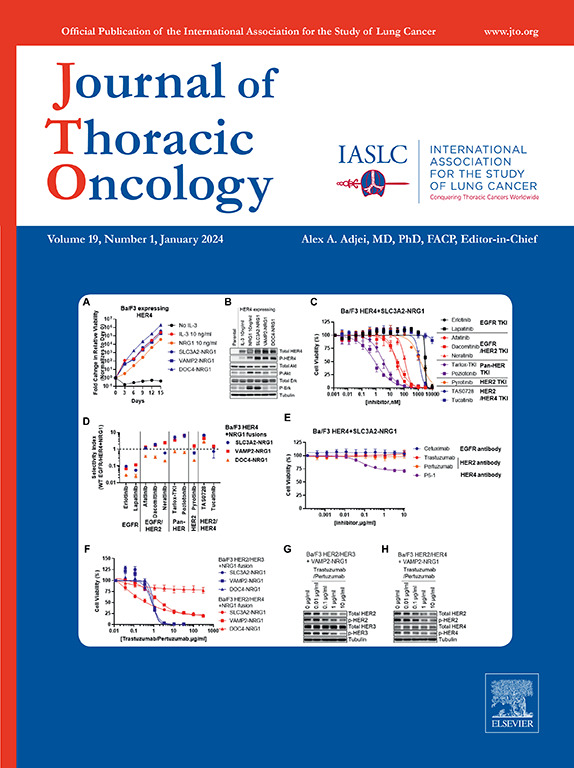用于检测治疗期间表皮生长因子受体突变阳性晚期非小细胞肺癌进展的循环肿瘤 DNA 纵向分析:来自 FLAURA 和 AURA3 的数据。
IF 21
1区 医学
Q1 ONCOLOGY
引用次数: 0
摘要
导言:表皮生长因子受体-酪氨酸激酶抑制剂(EGFR-TKI)致敏突变和耐药突变可通过循环肿瘤DNA(ctDNA)在血浆中检测到。本分析旨在确定纵向表皮生长因子受体突变ctDNA检测是否能在放射学检测之前发现进展性疾病(PD):这是对两项三期试验(FLAURA,NCT02296125;AURA3,NCT02151981)进行的一项回顾性、探索性ctDNA分析。患者均为未经治疗(FLAURA)或EGFR-TKI预处理(AURA3)的晚期非小细胞肺癌(NSCLC)患者,具有EGFR突变和研究中PD(RECIST),基线ctDNA结果和第3周期第1天后的EGFR突变ctDNA监测。患者接受奥希替尼与对比EGFR-TKIs(FLAURA)或化疗(AURA3)。结果包括从ctDNA PD到RECIST PD的时间,以及到首次后续治疗(FST;仅FLAURA)的时间。结果:在FLAURA中,93/146(64%)例患者的ctDNA PD先于/并发于RECIST定义的PD;在AURA3中,82/146(56%)例患者的ctDNA PD先于/并发于RECIST定义的PD。从ctDNA PD到RECIST定义的PD的中位时间(月),在奥希替尼和对比药EGFR-TKI治疗组(FLAURA)分别为3.4和2.6,在奥希替尼和化疗组(AURA3)分别为2.8和1.5。在FLAURA中,从ctDNA PD到FST的中位时间(月)分别为6.0个月和4.7个月,奥希替尼组(n = 51)和EGFR-TKI对照组(n = 70)分别为6.0个月和4.7个月:在接受表皮生长因子受体突变阳性晚期NSCLC患者中,接受EGFR-TKI或化疗且有ctDNA数据和RECIST定义的PD的患者中,约60%的病例在RECIST定义的PD之前/同时出现ctDNA PD。ctDNA纵向监测可在放射学PD之前发现PD。本文章由计算机程序翻译,如有差异,请以英文原文为准。
Longitudinal Analyses of Circulating Tumor DNA for the Detection of EGFR Mutation-Positive Advanced NSCLC Progression During Treatment: Data From FLAURA and AURA3
Introduction
EGFR tyrosine kinase inhibitor (EGFR-TKI)-sensitizing and -resistance mutations may be detected in plasma through circulating tumor DNA (ctDNA). Circulating tumor DNA level changes reflect alterations in tumor burden and could be a dynamic indicator of treatment effect. This analysis aimed to determine whether longitudinal EGFR-mutation ctDNA testing could detect progressive disease (PD) before radiologic detection.
Methods
This was a retrospective, exploratory ctDNA analysis in two phase 3 trials (FLAURA, NCT02296125; AURA3, NCT02151981). Patients had treatment-naïve (FLAURA) or EGFR-TKI pre-treated (AURA3) advanced NSCLC with EGFR mutations and on-study PD (RECIST [Response Evaluation Criteria in Solid Tumors]), with a baseline ctDNA result and EGFR-mutation ctDNA monitoring beyond Cycle 3 Day 1. Patients received osimertinib versus comparator EGFR-TKIs (FLAURA) or chemotherapy (AURA3). Outcomes included time from ctDNA PD to RECIST PD and the first subsequent treatment (FLAURA only).
Results
Circulating tumor DNA PD preceded or co-occurred with RECIST-defined PD in 93 out of 146 patients (64%) in FLAURA and 82 out of 146 patients (56%) in AURA3. Median time from ctDNA PD to RECIST-defined PD (mo) was 3.4 and 2.6 in the osimertinib and comparator EGFR-TKI arms (FLAURA) and 2.8 and 1.5 in the osimertinib and chemotherapy arms (AURA3). In FLAURA, the median time from ctDNA PD to the first subsequent treatment (mo) was 6.0 and 4.7 in the osimertinib (n = 51) and comparator EGFR-TKI arms (n = 70).
Conclusions
Among patients with EGFR mutation-positive advanced NSCLC receiving EGFR-TKI or chemotherapy with ctDNA data and RECIST-defined PD, ctDNA PD preceded/co-occurred with RECIST-defined PD in approximately 60% of cases. Longitudinal ctDNA monitoring may detect PD before radiologic PD.
求助全文
通过发布文献求助,成功后即可免费获取论文全文。
去求助
来源期刊

Journal of Thoracic Oncology
医学-呼吸系统
CiteScore
36.00
自引率
3.90%
发文量
1406
审稿时长
13 days
期刊介绍:
Journal of Thoracic Oncology (JTO), the official journal of the International Association for the Study of Lung Cancer,is the primary educational and informational publication for topics relevant to the prevention, detection, diagnosis, and treatment of all thoracic malignancies.The readship includes epidemiologists, medical oncologists, radiation oncologists, thoracic surgeons, pulmonologists, radiologists, pathologists, nuclear medicine physicians, and research scientists with a special interest in thoracic oncology.
 求助内容:
求助内容: 应助结果提醒方式:
应助结果提醒方式:


